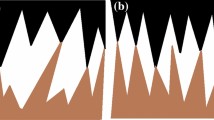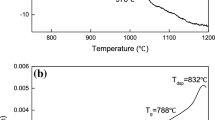Abstract
This paper reports the highest etch depth of annealed Pyrex glass achieved by wet etching in highly concentrated HF solution, using a low stress chromium–gold with assistance of photoresist as masking layer. The strategies to achieve that are: increasing the etch rate of glass and simultaneously increasing the resistance of Cr/Au mask in the etchant. By annealing the Pyrex glass and using a highly concentrated HF acid, a high etch rate can be obtained. Furthermore, a method to achieve a good resistance of the Cr/Au masking layer in the etching solution is to control the residual stress and to increase the thickness of Au deposition up to 1 μm. In addition, the presence of a hard baked photoresist can improve the etching performance. As a result, a 500-μm thick Pyrex glass wafer was etched through.







Similar content being viewed by others
References
Bien DCS, Rainey PV, Mitchel SJM, Gamble HS (2003) Characterization of masking materials for deep glass micromachining. J Micromech Microeng 13:S34–S40
Bu M, Melvin T, Ensell GJ, Wilkinson JS, Evans AGR (2004) A new masking technology for deep glass etching and its microfluidic application. Sens Actuators A 115(2–3):476–482
Corman T, Enokson P, Stemme G (1998) Deep wet etching of borosilicate glass using anodically bonded silicon substrate as mask. J Micromech Microeng 8:84–87
Fujita T, Maenaka K, Mizuno T, Matsuoka T, Kojima T, Oshima T, Maeda M (2000) Disk-shaped bulk micromachined gyroscope with vacuum sealing. Sens Actuators A 82(1–3):198–204
Grettilat MA, Paoletti F, Thiebaud P, Roth S, Kondelka-Hep M, de Rooij NF (1997) A new fabrication method for borosilicate glass capillary tubes with lateral inlets and outlets. Sens Actuators A 60:219–222
Grosse A, Grewe M, Fouckhardt H (2001) Deep wet etching of fused silica glass for hallow capillary optical leaky waveguides in microfluidic devices. J Micromech Microeng 11:257–262
Iliescu C, Miao J, Tay FEH (2005) Stress control in masking layers for deep wet micromachining of Pyrex glass. Sens Actuators A 117(2):286–292
Kim C, Kim Y (2002) Micro XY-stage using silicon on a glass substrate. J Micromech Microeng 12:103–107
Li X, Abe T, Esashi M (2002) Fabrication of high-density electrical feed-throughs by deep- reactive-ion etching of Pyrex glass. J Microelectromech Syst 1(6):625–630
Luginbuhl Ph, Indermuhle PF, Gretillat MA, Willemin F, de Rooij NF, Gerber D, Gervasio G, Vuilleumier JL, Twerenbold D, Duggelin M, Guggenheim R (1999) Micromachined injector for DNA mass spectrometry. In: Proceedings on Transducers’99, pp 1130–1133
Madou MJ (2002) Fundamentals of microfabrication, 2nd edn. CRC Press, Boca Raton
Obeid PJ, Christopoulos TK, Crabtree HJ, Backhouse CJ (2003) Microfabricated device for DNA and RNA amplification by continuous-flow polymerase chain reaction and reverse transcription-polymerase chain reaction with cycle number selection. Anal Chem 75:288–295
Roylance L, Angell J (1978) A miniature integrated circuit accelerometer. In: Solid state circuits conference, pp 220–221
Rusu C, van’t Oever R, de Boer MJ, Jansen HV, Berenschot JW, Bennink ML, Kanger JS, de Grooth BG, Elwenspoek M, Greve J, Brugger J, van den Berg A (2001) Direct integration of micromachined pipettes in a flow channel for single DNA molecule study by optical tweezers. J Microelectromech Syst 10:238–246
Shoji S, Kikuchi H, Torigoe H (1997) Low-temperature anodic bonding using lithium aluminosilicate-β-quartz glass ceramic. Sens Actuators A 64:95–100
Simpson PC, Woolley AT, Mathies RA (1998) Microfabrication technology for the production of capillary array electrophoresis chips. Biomed Microdevice 1(1):7–25
Stjernström M, Roeraade J (1998) Method for fabrication of microfluidic systems in glass. J Micromech Microeng 8:33–38
Acknowledgement
This project is funded by the Institute of Bioengineering and Nanotechnology, Agency for Science, Technology and Research (IBN/04-R44007-OOE).
Author information
Authors and Affiliations
Corresponding author
Rights and permissions
About this article
Cite this article
Tay, F.E.H., Iliescu, C., Jing, J. et al. Defect-free wet etching through pyrex glass using Cr/Au mask. Microsyst Technol 12, 935–939 (2006). https://doi.org/10.1007/s00542-006-0116-0
Received:
Accepted:
Published:
Issue Date:
DOI: https://doi.org/10.1007/s00542-006-0116-0




